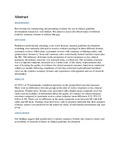| dc.description.abstract | BACKGROUND:
Best formats for summarising and presenting evidence for use in clinical guideline development remain less well defined. We aimed to assess the effectiveness of different evidence summary formats to address this gap.
METHODS:
Healthcare professionals attending a one-week Kenyan, national guideline development workshop were randomly allocated to receive evidence packaged in three different formats: systematic reviews (SRs) alone, systematic reviews with summary-of-findings tables, and 'graded-entry' formats (a 'front-end' summary and a contextually framed narrative report plus the SR). The influence of format on the proportion of correct responses to key clinical questions, the primary outcome, was assessed using a written test. The secondary outcome was a composite endpoint, measured on a 5-point scale, of the clarity of presentation and ease of locating the quality of evidence for critical neonatal outcomes. Interviews conducted within two months following completion of trial data collection explored panel members' views on the evidence summary formats and experiences with appraisal and use of research information.
RESULTS:
65 (93%) of 70 participants completed questions on the prespecified outcome measures. There were no differences between groups in the odds of correct responses to key clinical questions. 'Graded-entry' formats were associated with a higher mean composite score for clarity and accessibility of information about the quality of evidence for critical neonatal outcomes compared to systematic reviews alone (adjusted mean difference 0.52, 95% CI 0.06 to 0.99). There was no difference in the mean composite score between SR with SoF tables and SR alone. Findings from interviews with 16 panelists indicated that short narrative evidence reports were preferred for the improved clarity of information presentation and ease of use.
CONCLUSIONS:
Our findings suggest that 'graded-entry' evidence summary formats may improve clarity and accessibility of research evidence in clinical guideline development | en_US |

